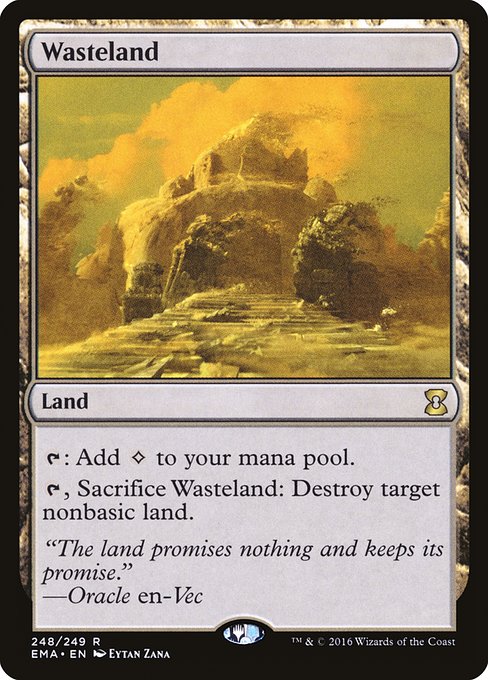
Image courtesy of Scryfall.com
Perspective and Depth in Wasteland’s Artwork
There’s something quietly electric about the way a great MTG card lets you step into a scene with your own imagination. The Eternal Masters reprint of Wasteland does precisely that, inviting you to trace the horizon with your eyes and feel the space stretch beyond the frame. 🧙♂️ The art, produced by Eytan Zana, uses perspective as a storytelling device: foreground details push forward, midground structures anchor the eye, and a distant, hazy skyline recedes into the background—creating a layered battlefield that mirrors the card’s strategic depth. This is not just a pretty picture; it’s a study in how space can communicate potential, danger, and quiet, patient power. 🔥
A designer’s eye: pushing depth with simple tools
Depth in illustration often comes down to a handful of cues: overlapping forms, scale, atmospheric perspective, and directional lighting. In this piece, Zana leverages those elements to imply vastness without clutter. The near-ground textures—cracked earth, subtle rock textures, and tiny debris—anchor the viewer in the immediate, while the midground introduces shapes that are clearly subordinate in scale but essential to the composition. The horizon line sits deliberately low, inviting the eye to travel from foreground to faraway silhouettes, a classic painter’s trick that translates beautifully to the card frame. The result is a sense of stillness that could be broken at any moment by a sudden gust or flash of light—a perfect echo of the land’s quiet, inexorable power. 🎨
Colorless mood: palette as a narrative device
Even though Wasteland is a colorless land—producing {C} mana—the palette of the artwork itself leans into a restrained, earthy spectrum: muted browns, stone grays, and hints of muted greens. This restraint mirrors the mechanic on the card: no flashy mana costs to pay, just the promise of possibility carried by a barren surface. The lack of vibrant color doesn’t translate to a lack of emotion; rather, it heightens the drama of contrast, where the few focal points—maybe a shard of sunlight catching metal, or a storm-wrought skyscape—pop with quiet intensity. The result is an image that feels timeless, like a memory of a world that once was and might be again in the right, ruthless moment. 💎⚔️
“The land promises nothing and keeps its promise.” — Oracle en-Vec
Lore, flavor, and the visual narrative
Wasteland’s flavor text cuts to the heart of the image’s mood: scarcity, inevitability, and the stubborn persistence of a landscape that offers opportunities only on its own terms. The artwork complements this narrative by presenting a terrain that is at once open and constrained—a place where every rise and ridge hints at consequences and every shadow suggests a risk. The artist’s linework and texture sense add grit to the scene, while the atmospheric haze softens edges in the distance, reminding us that the world is larger than any single moment a game can hold. This alignment between art and text makes Wasteland feel like more than a card; it feels like a setting you could step into with a single turn, if the moment asked for it. 🎲
Mechanics meet imagery: the card in play
From a gameplay perspective, Wasteland embodies a stark, strategic philosophy: you generate pure, colorless mana, and you can spend it to alter the board by destroying an opponent’s nonbasic land—at the cost of sacrificing your own. That thematic punch is mirrored in the art’s composition. The barren landscape is not empty; it is full of potential—just like a land that taps for mana and can annihilate threats when you decide the timing is right. In formats like Legacy and Commander, where land destruction has a storied role, the card’s visuals reinforce the psychological edge: you’re not simply removing a threat; you’re reshaping the battlefield’s horizon. The art’s depth helps remind players that every choice carries weight, and the space between land drops is filled with implied consequence. ⚔️
Collector’s note: value and context
As a rare from the Eternal Masters set, Wasteland sits among reprint legends that bridge vintage nostalgia with modern accessibility. The card’s standing in EDHREC with a respectable ranking speaks to its enduring relevance in Commander circles, where colorless lands and utility-based destruction find a home in numerous archetypes. The market data surrounding the Eternal Masters print—roughly around $20 USD for the non-foil and a touch higher for foil—reflects both its curated rarity in a Masters-wide reprint and the continuing love fans have for classic land disruption. For collectors, the piece is not just a strategic tool but a window into how artists interpret the same fundamental idea of scarcity and control across decades. 🔎💎
Why art matters in deck-building and memory
Every revisit to Wasteland’s image invites a new appreciation for how perspective and depth influence our memory of a card. The feeling of standing on that cracked plain, the sense that something essential sits just beyond the hill, mirrors the decision-making process in the game: when to tap for colorless mana, when to sacrifice the land for a strategic purge, and how to balance tempo with a plan for late-game inevitability. The art teaches patience, a virtue all seasoned players know well. And for the art lover in all of us, it’s a reminder that MTG’s legendary landscape can be as immersive as any novel or film. 🧙♂️🎨
For readers who want a little real-world utility alongside their mana strategy, consider a handy gadget that pairs well with long play sessions and travel to your next event. This cross-promo product can keep your focus sharp between rounds and your phone steady during brews with friends. Phone Click-On Grip Portable Phone Holder Kickstand—a practical companion for those tournament breakfasts, wallet checks, and last-minute deck checks between games.